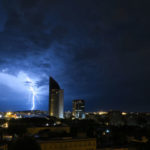Lens compression is a bit of a misnomer. It doesn’t compress anything, really—rather, it’s a type of lens distortion, like a fisheye or wide-angle lens. It affects how close or far backgrounds look in an image, even if the subject is in exactly the same spot. This video, less than three minutes long, does an excellent breakneck breakdown of how to understand lens compression:
Hosted by Pye Jirsa, the video aims to show honest, straightforward differences between Canon lenses. He grabbed seven prime lenses, placed a female model on a tree branch, and adjusted their camera placement so that she was always in the same spot of the frame.
What is Lens Compression?
Basically, the closer the camera is to the object, the farther away the background appears; the farther the lens, the closer together everything looks.
The easiest way to understand it is by seeing it in sequential order. The lens used is cited in the bottom-left of each image, along with the shutter speed and aperture settings:
With the 24mm lens, the tree looks like it extends a good few feet behind the model.
The background is starting to get more compressed with the 35mm…
And more…
As you can see, by the 300mm lens, it basically appears as though the tree is right next to the model. The physics of the shot have completely changed.
There’s no “better” or “worse” look, just what style you’re aiming for.
“It is a type of lens distortion. But that doesn’t mean that it’s bad. In fact, we use lens compression oftentimes to create awesome compositions that really wouldn’t be possible otherwise.” – Pye Jirsa
Like This Article?
Don't Miss The Next One!
Join over 100,000 photographers of all experience levels who receive our free photography tips and articles to stay current:













Its not the distance of the lens away from the subject but the focallenght
I was trying to describe exactly what Bernie Raffe described. His description may be more clear than my own.
When I first discovered this it blew my mind. The “compressed” telephoto version of one of my images, and the “uncompressed” wide angle version, were the same image, but I had cropped it. The effect was very strong, but it was only perception-based.
Nice but sir if you click in 50mm object behind that will go means outfocus…………………………………..
This isn’t lens compression, sorry but I feel the title is misleading.The ‘compression’ is mostly caused by the change of perspective due to the fact you were standing further back.
If you were standing next to two tall buildings and they were 100 metres apart, they would look 100 metres apart. But if you were a mile away, the buildings would look closer together because of the change of perspective. The camera just records that fact.
You can get the same effect by cropping the wider angled images. The lens distortion demonstrated here isn’t distortion.
How does it work? The same as the moon, which looks closer to us (larger) when it’s on the horizon, and farther or smaller when it’s higher in the sky. Both the moon, and the lens compression examples are based on comparing the size of objects in the background to foreground; the wider angled photos simply have larger foregrounds than the telephoto images, so we perceive the background objects as being smaller, and smaller means farther away.
This is easy enough to prove. Do exactly what the video shows, and then take the widest angle lens and start cropping and comparing.